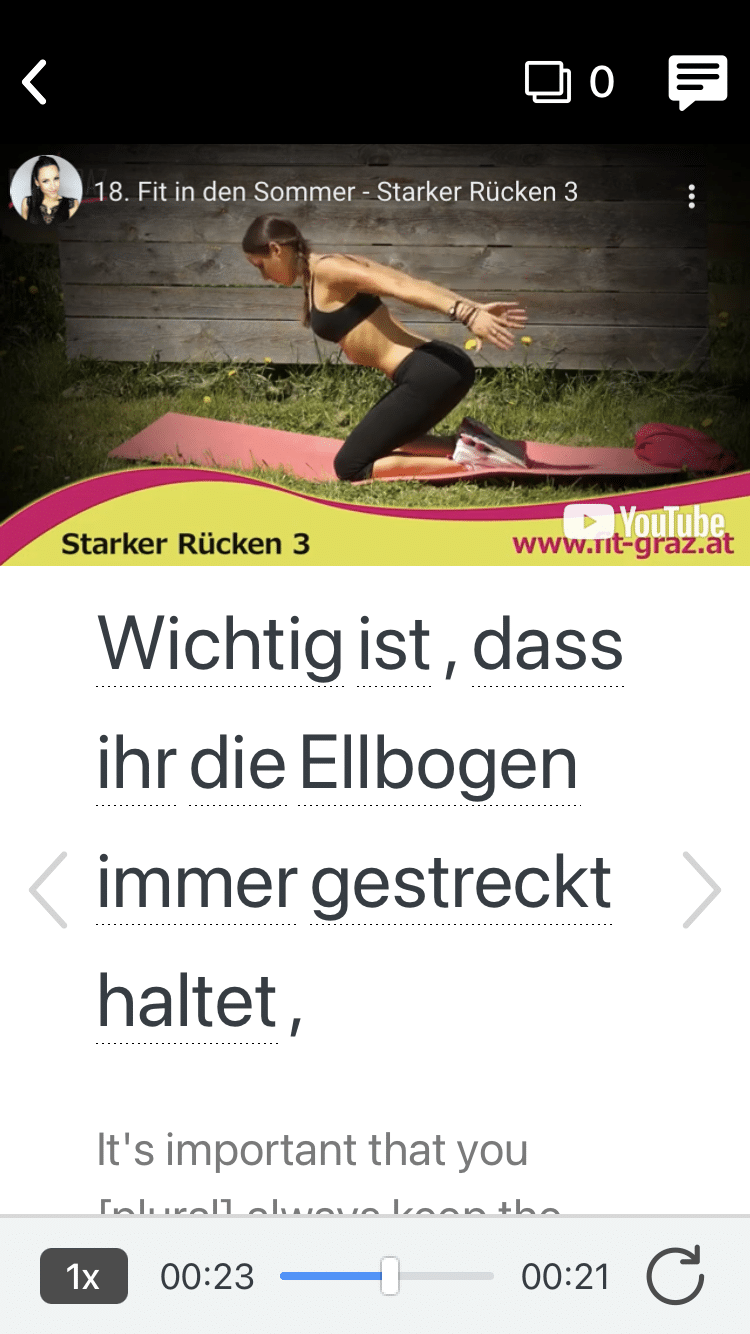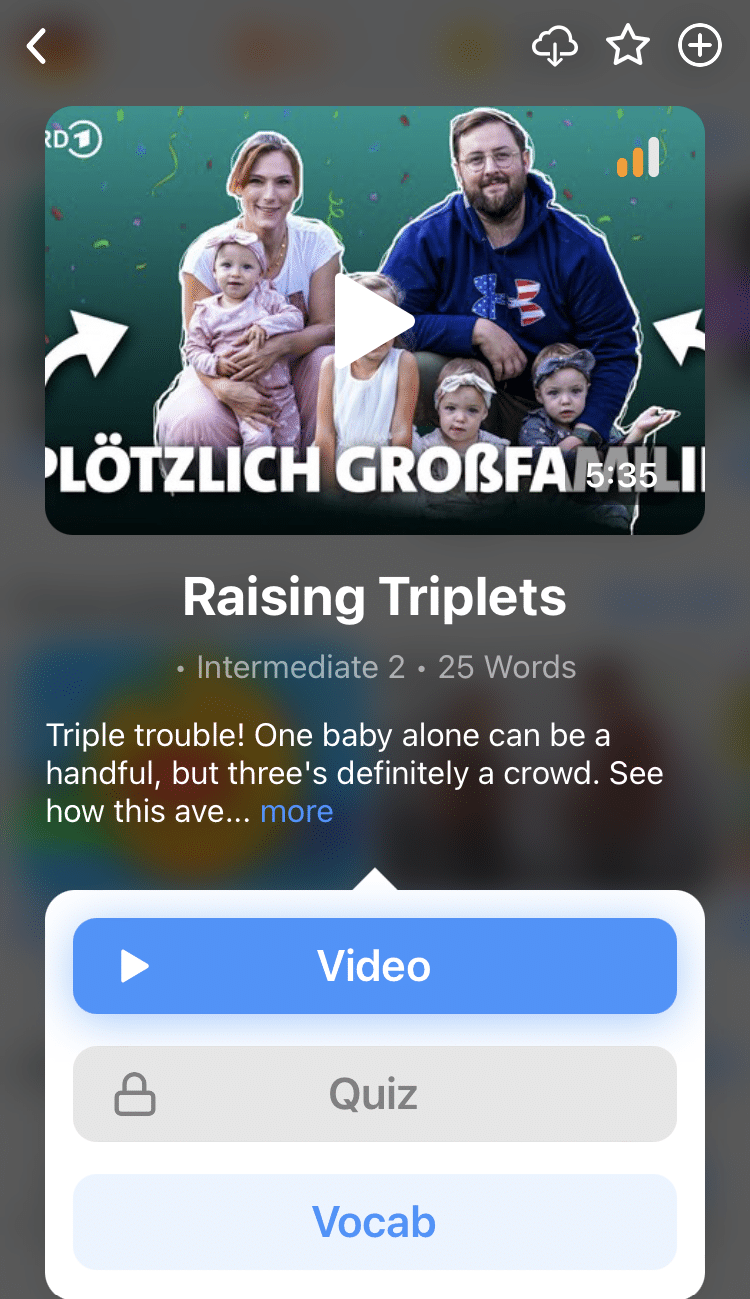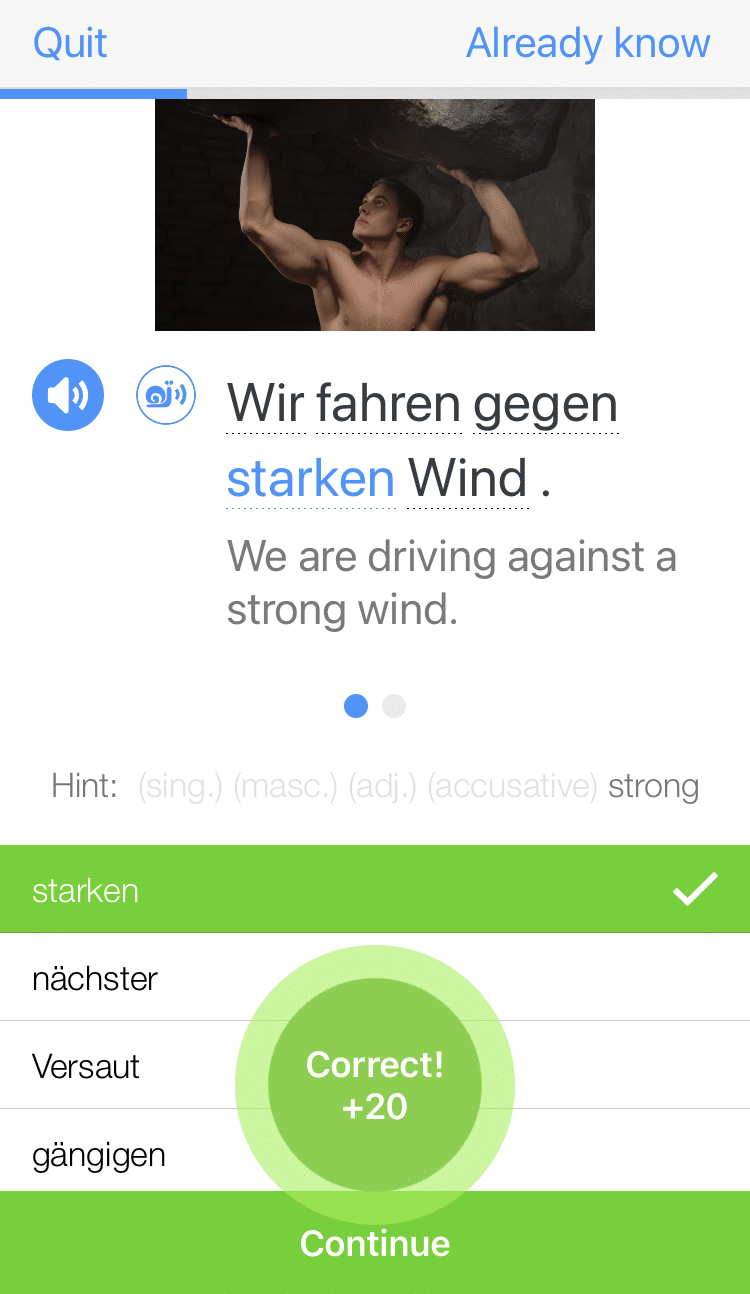
2 Simple Steps to Always Get German Adjective Endings Right
Correct adjective endings seem like small details, but they are critical to your overall German fluency.
Not knowing them could mean losing a potential job, romantic prospect or, worst of all, a German placement test.
Follow this simple two-step approach and you’ll be able to get German adjectives right every time!
Contents
- How to Get German Adjective Endings Right Each Time
- Practicing Adjective Endings with 7 Real-life Examples
- 1. Fast d__ gesamt_ Kriegszeit verbringt Rosa Luxemburg in Gefängnissen.
- 2. Weitere Dissidenten formieren sich zu_ innerparteilich_ Anti-Kriegs-Fraktion.
- 3. D__ ultralink_ Spartakusgruppe, 1916 von Liebknecht und Luxemburg gegründet, schließt sich ihr an.
- 4. Dabei möglicherweise __ “ungut__ Eindruck” zu machen, steht hinter diesem Ziel zurück.
- 5. Jed__ Tag mein__ Lebens wäre anders verlaufen.
- 6. Ich bin i_ rheinhessisch__ Dorf Wiesoppenheim aufgewachsen.
- 7. Di__ ander__ Kinder hätten mich sofort auf die Tatsache hingewiesen, dass mein_ Eltern nicht mein_ “richtig__ Eltern” seien.
- And One More Thing...
Download: This blog post is available as a convenient and portable PDF that you can take anywhere. Click here to get a copy. (Download)
How to Get German Adjective Endings Right Each Time
Step 1: Determine the correct form of the article
The correct form of the article has two components:
- the noun’s gender
- the noun’s case
So, the magic formula’s two ingredients are both famous oh-my-god-I-can-never-learn-German aspects of the language – like German word order. The gender of the noun is something you’ll have to memorize or look up in the dictionary every time – just be glad that with the LEO dictionary it only takes a few seconds.
The case of the noun can be nominative, accusative, dative or genitive. Generally, nominative is the subject of the sentence, accusative the object, dative the indirect object and genitive just adds an “of.” There are some verbs or situations in which the apparent subject is actually in dative, like “Mir ist warm” (I am warm) or “Mir hat es gefallen” (It pleased me), and some verbs that have a dative object instead of an accusative object. Though this might seem daunting at first, it’s such an integral part of understanding the meaning of a sentence that you’ll get better at it very quickly.
Once you know the gender and the case, just take a look at these tables and voila: you’ve got the correct form of the article!
The definite article der, and similar article-like words dieser, jener, jeder, mancher, welcher and solcher all decline according to the following table.
Masc. Fem. Neut. Plur.
Nom. Der Die Das Die
Acc. Den Die Das Die
Dat. Dem Der Dem Den
Gen. Des Der Des Der
The indefinite article ein, the possessive pronouns (mein, dein, usw.), and the negation pronoun kein all decline according to the following table:
Masc. Fem. Neut.
Nom. Ein Eine Ein
Acc. Einen Eine Ein
Dat. Einem Einer Einem
Gen. Eines Einer Eines
Step 2: Find the correct adjective ending
There are two kinds of adjective endings, the strong ending and the weak ending, which roughly correspond to the two tables above. Whether you use a strong ending or a weak ending depends on which article (der, ein) is used.
After an indefinite article, use the strong ending. After a definite article, use the weak ending.
Basically, the form of the direct article, which distinguishes between the sex of nouns, like der or das, needs to be used at least once when describing a noun, either in the article or in the adjective ending.
Strong Ending Rules
In any of the following three cases, the adjectives take what is called the strong ending:
- Indefinite articles
- Possessives
- kein/keinen/keine
Strong Ending Table
Masc. Fem. Neut.
Nom -er -e -es
Akk -en -e -es
Dat -en -en -en
Gen -en -en -en
Mein biologischer Vater war ein großer Mann
(Nom., Possessive, der Vater) (Nom., indefinite article, der Mann)
Meine neue Freundin trägt keine blaue Jeans, nur Kleider
(Nom., Possessive, die Freundin) (Acc., kein, die Jeans)
Höllandisches Bier hat einfach keinen guten Geschmack
(Nom., no article, das Bier) (Acc., kein, der Geschmack)
Sie traf einen netten Amerikaner an der Bushaltestelle
(Acc., indefinite article, der Amerikaner)
Er trank ein kleines Bier
(Acc., indefinite article, das Bier)
Weak Ending Table
Masc. Fem. Neut.
Nom -e -e -e
Akk -en -e -e
Dat -en -en -en
Gen -en -en -en
When you use indefinite articles, you get strong inflection with nominative and accusative singular endings: ein kleines Bier, eine gute Sache, ein neuer Wagen.
But, all other forms in dative and genitive (ending “-en“) have weak endings.
Ich habe noch nie einen Abend verbracht mit solchen witzigen Typen.
[dative plural]
(I’ve never spent an evening with such funny guys.)
Ich brauche deine Hilfe mit diesem chinesischen Rezept.
[dative, das Rezept]
(I need your help with this Chinese recipe.)
Welcher Mitarbeiter ist für dieses Projekt zuständig?
[der Mitarbeiter, nominative; das Projekt, accusative]
(Which employee is responsible for this project?)
For examples of native German speakers using these adjective endings in diverse sentence, you can check out FluentU.
FluentU takes authentic videos—like music videos, movie trailers, news and inspiring talks—and turns them into personalized language learning lessons.
You can try FluentU for free for 2 weeks. Check out the website or download the iOS app or Android app.
P.S. Click here to take advantage of our current sale! (Expires at the end of this month.)
And now, for the German adjective endings two-step.
Practicing Adjective Endings with 7 Real-life Examples
I think that the only way I could possibly help you get better at this is to give you a series of exercises where I parse the sentence for you.
They’re all from articles from Zeit Online, a German weekly newspaper known for its high-quality journalism.
These sentences might seem too difficult for most beginning learners of German. But remember, you don’t have to understand every word in these sample sentences. What we’re trying to learn here is how to decline the articles and find the correct adjective ending.
Please note that the translations provided are going to sound weird. They’re intentionally more literal translations of the German, rather than natural-sounding English sentences.
1. Fast d__ gesamt_ Kriegszeit verbringt Rosa Luxemburg in Gefängnissen.
English Translation: Rosa Luxemburg spent almost the entire duration of the war in prisons.
[gesamt, die Kriegszeit]
“Verbringen,” meaning to spend time somewhere, like “Wir verbrachten den ganzen Abend zusammen” puts the noun that it refers to in the accusative case, which leaves the article as die. The definite article gives the adjective a strong ending:
Fast die gesamte Kriegszeit
2. Weitere Dissidenten formieren sich zu_ innerparteilich_ Anti-Kriegs-Fraktion.
English Translation: Other dissidents form the Anti War faction within the party.
[innerparteilich, die Fraktion]
“Zu” is a preposition that is always dative. It forms the contractions “zum” and “zur” from “zu dem” and “zu der.” The definite article means a weak ending, and “Weitere Dissidenten” is an example of no article nominative plural, which results in a strong ending.
3. D__ ultralink_ Spartakusgruppe, 1916 von Liebknecht und Luxemburg gegründet, schließt sich ihr an.
English Translation: She joined the ultra-left Spartacus group, founded in 1916 by Liebknecht and Luxemburg.
[ultralink, die Gruppe]
Nominative feminine, weak ending because of the definite article.
Die ultralinke Spartakusgruppe
4. Dabei möglicherweise __ “ungut__ Eindruck” zu machen, steht hinter diesem Ziel zurück.
English Translation: Making a “bad impression” is secondary to this goal.
[ungut, der Eindruck]
Accusative masculine, and an indefinite article requires a weak ending.
Einen unguten Eindruck
5. Jed__ Tag mein__ Lebens wäre anders verlaufen.
English Translation: Every day of my life would have been different.
[Jeder/Jede/Jedes, der Tag, mein, das Leben]
Jeder Tag the subject of the sentence, is nominative and this can show you how “Jeder” declines. Hopefully you were also able to realize that “of my life” requires genitive to show possession. See, genitive is alive and well! There were no adjectives here, but they would have the weak ending for jeder and the strong ending for meines.
Jeder Tag meines Lebens
6. Ich bin i_ rheinhessisch__ Dorf Wiesoppenheim aufgewachsen.
English Translation: I grew up in the village of Wiesoppenheim in Rhine Hesse.
[rheinhessisch, das Dorf]
“In” is a dual preposition that is dative most of the time, but is accusative when the verb involves movement. “Aufwachsen” is a fairly stative activity if you give it some thought. I’m quite impressed with how easy it is to turn proper nouns into adjectives in German; why should there be a single adjective meaning “the area of Hessia near the Rhine”? Weak ending for the contracted “in dem…” definite article.
im rheinhessischen Dorf
7. Di__ ander__ Kinder hätten mich sofort auf die Tatsache hingewiesen, dass mein_ Eltern nicht mein_ “richtig__ Eltern” seien.
English Translation: The other children would have immediately alerted me to the fact that my parents weren’t my “real parents.”
[ander, die Kinde (plural), die Eltern (plural)]
Because the verb here “seien” is a form of the verb “to be” (sein), that means that both nouns which it refers to are in the nominative case. However, because they are both plural, there is no difference here between the weak ending and strong ending.
Die anderen Kinder
Meine richtigen Eltern
My best advice to you for your continued German career is to try to look at as many primary source German pieces as you can. If the only German sentences you’re exposed to are spoon-fed from dull textbooks written in the 1970’s, like when I learned German in high school, then you’re never going to be able to find German interesting enough to stick with it.
Download: This blog post is available as a convenient and portable PDF that you can take anywhere. Click here to get a copy. (Download)
And One More Thing...
Want to know the key to learning German effectively?
It's using the right content and tools, like FluentU has to offer! Browse hundreds of videos, take endless quizzes and master the German language faster than you've ever imagine!
Watching a fun video, but having trouble understanding it? FluentU brings native videos within reach with interactive subtitles.
You can tap on any word to look it up instantly. Every definition has examples that have been written to help you understand how the word is used. If you see an interesting word you don't know, you can add it to a vocabulary list.
And FluentU isn't just for watching videos. It's a complete platform for learning. It's designed to effectively teach you all the vocabulary from any video. Swipe left or right to see more examples of the word you're on.
The best part is that FluentU keeps track of the vocabulary that you're learning, and gives you extra practice with difficult words. It'll even remind you when it’s time to review what you’ve learned.
Start using the FluentU website on your computer or tablet or, better yet, download the FluentU app from the iTunes or Google Play store. Click here to take advantage of our current sale! (Expires at the end of this month.)







